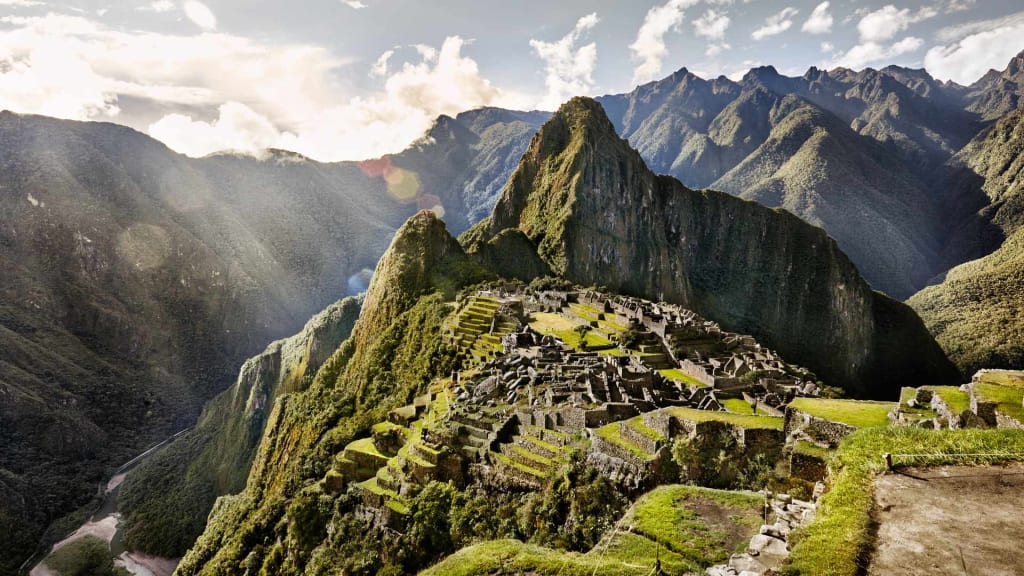
Nestled high in the slopes of the Andes, Machu Picchu was discovered by Hiram Bingham III in 1911. This was a hidden capital to which the Inca had escaped after the Spanish conquistadors arrived in 1532. Over time it became famous as the legendary Lost City of the Inca. Recent research has cast doubt on whether Machu Picchu had ever been forgotten at all. When Bingham arrived, three families of farmers were living at the site.
There are no written records of the site while it was in use. The names of the buildings, their supposed uses, and their inhabitants are the product of modern archaeologists based on physical evidence, including tombs at the site. The stones in the most handsome buildings throughout the Inca Empire used no mortar. These stones were cut so precisely, and wedged so closely together. Peru is a seismically unstable country—both Lima and Cusco have been leveled by earthquakes—and Machu Picchu itself was constructed atop two fault lines. When an earthquake occurs, the stones in an Inca building are said to tremble, they bounce through the tremors and then fall back into place. Without this building method, many of the best known buildings at Machu Picchu would have collapsed long ago. Historical research published in 2022 claims that the site was probably called Huayna Picchu by the Inca people themselves, as it exists on the smaller peak of the same name, with Huayna meaning "young" in the Quechua language, Machu means "old and while pikchu means "pyramid" or "cone". The name Machu Picchu became associated with the ruins.
THE CONSTRUCTION
Development seems to date from two incredible Inca rulers, Pachacutec Inca Yupanqui (1438-1471) and Túpac Inca Yupanqui (1472-1493). There is an agreement among archeologists that Pachacutec requested the development of the imperial estate for his utilization as a retreat, in all likelihood after an effective military mission. Despite the fact that Machu Picchu is viewed as a "royal" home, it could never have been passed down in the line of succession. Rather it was utilized for a long time prior to being deserted, apparently as a result of the Spanish successes in different parts of the Inca Empire. It is conceivable that the majority of its occupants died from smallpox that might have came with travelers before the Spanish conquerors showed up nearby.
One of the strangest things about Machu Picchu is that the site provides virtually no information about the ruins. You have to find the Museo de Sitio Manuel Chávez Ballón museum that have all the information on how and why Machu Picchu was built with displays in English and Spanish, and why the Inca chose such an extraordinary natural location for the citadel. From the second Hiram Bingham stumbled up to Machu Picchu in 1911, guests have perceived that the ruins' natural setting is as critical to the site as the actual structures. Late exploration has shown that the site's area, and the direction of its most significant designs, was firmly impacted by the area of neighboring sacred mountains, or apus. A bolt formed stone on the pinnacle of Huayna Picchu seems to point due south, straightforwardly through the popular Intihuatana Stone, to Mount Salcantay, one of the most loved apus in Inca cosmology. On significant days of the Inca schedule, the sun should be visible to rise or set behind other huge peaks.
MACHU PICCHU AS A TOURISM DESTINATION
You will spend hours wandering and being amazed from marvel to marvel in this Inca city of wonders. here is a list of things to do:
Great views at the Sun Gate
Emblematic Temple of the Sun
The Sacred Rock
Hike up to Huayna Picchu mountain
Visit the Temple of the Moon
Climb Machu Picchu mountain
Intihuatana (a beautifully carved rock)
Visit the principal temple
Explore the Inca Bridge
Visit the agricultural terraces
Informative Machu Picchu museum
Colorful Mariposarium
About the Creator
Ntokozo Mvuni
Interesting stories 📚
Read to get intrigued
Enjoyed the story? Support the Creator.
Subscribe for free to receive all their stories in your feed. You could also pledge your support or give them a one-off tip, letting them know you appreciate their work.






Comments
There are no comments for this story
Be the first to respond and start the conversation.